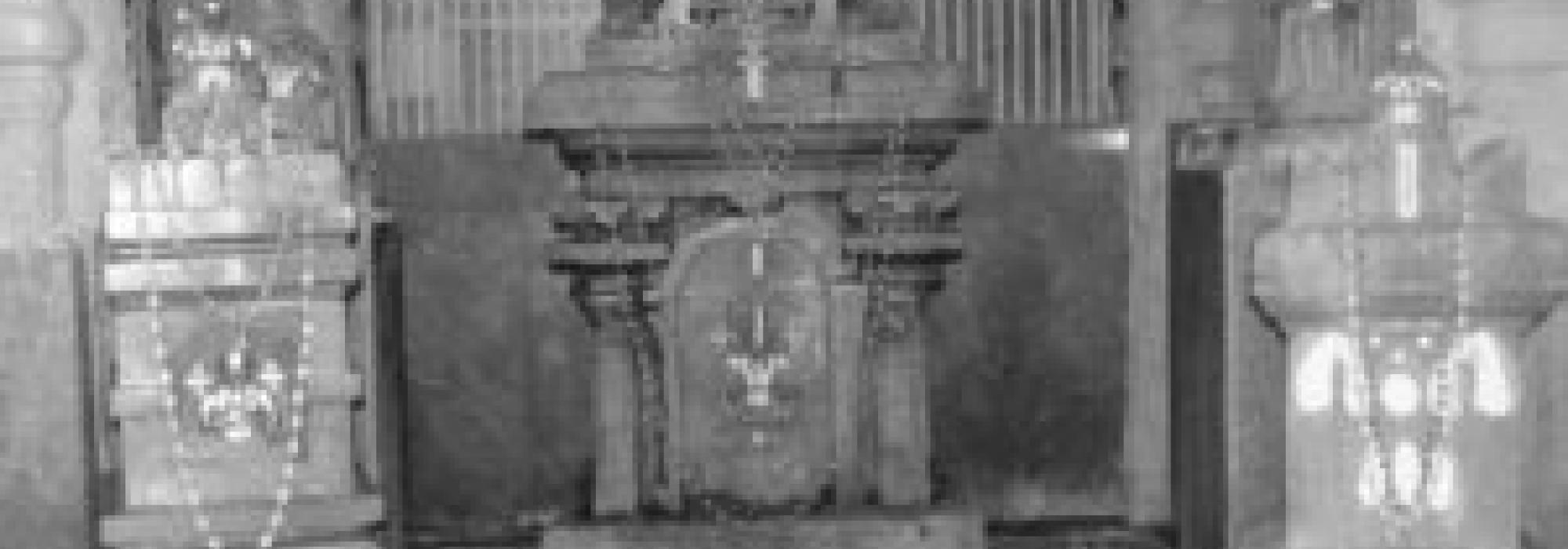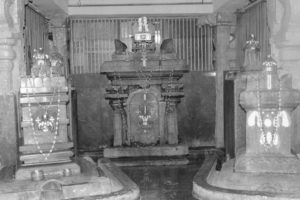There was a large population of Madhva Brahmanas in Mulabagal. The locality they lived was divided as the Upper and the Lower Agraharas. In total, there were about two hundred and fifty or three hundred Madhva Brahmana homes. Of these, about a hundred and fifty or two hundred homes constituted those of the Vaidika Acharyas. Most of these folks were deeply learned in the school of Sri Madhvacharya’s Dvaita philosophy. Typically, traditional education and discourses was carried on in almost every such home. Prominent among these were the Swami of the Sripadaraya Matha, Appannacharya of the Vyasaraya Matha, Avaruru Narahari Acharya, Raghavendracharya, Madhvarayacharya, Kalluru Raghavendracharya, “Jaggery” Narashin Acharya, Hebbani Seshacharya, and Ramannacharya.
The Avaruru Brothers
Avaruru Narahari Acharya and Raghavendracharya were brothers. They lived in a vast mud-roofed house. The brothers would impart their lessons in two separate halls. Each of their classes was populated by six to eight students. The subjects they chiefly taught were Tarka (Logic) and Vedanta. Lessons would begin in the morning from eight till eleven, and in the evening, from four till seven. The teachers took no salary. No scholarships for students. No Government grant to this school. Zest for knowledge was the only capital investment. Avaruru Narahari Acharya’s son, Sri Vyasacharya was older to me by a couple of years. A Shweta-Chhatra (literally, White Umbrella) was tied on the ceiling of their house. This Shweta-Chhatra resembled that typically found in temples and Mathas. I inquired with Sri Vyasacharya. He said: “My grandfather or some other ancestor was apparently a towering Vidwan. The Swami of the Uttaradi Matha or some other Matha honoured him by taking him out in a procession in a palanquin. On that occasion, he was presented with this Umbrella as a token of honour. We didn’t know what to do with it. There’s no space for this item in our home. That’s why they’ve tied it there.” Narahari Acharya possessed a nature of quiet humour. The father or mother or grandfather typically enquired with him regarding the progress of their ward on these lines: “how’s our boy, Hanuman doing?” or “how’s our kid Bheema doing?” Sri Acharya wouldn’t know who they referred to by “Hanuman” or “Bheema.” He would turn to the person next to him. After they identified the said Hanuman or Bheema, he’d say, “Oh! That Bheema! He’s fine, he’s fine! He’d come to Sri Shyama Rao’s home the other day? That boy, right? He’s fine!” The parent would then ask, “How’s he learning?” To this, he would say, “Aha, aha!” and then change the subject. Both brothers were devoid of pride. It appeared as though they were completely unaware of the prowess of their own scholarship. Imparting lessons from morning till evening, being constantly engaged in the study of Shastras, performing daily Pujas and vratas—this was their life. The produce from the land that was donated to their ancestors by some ancient king or Palegara was their only source of livelihood. They didn’t have a money-earning profession like Pourohitya and allied occupations. Neither of them went out seeking an income. Mulabagal had two Madhva Mathas: the Sripadaraja Swami Matha and the Majjigehalli Swami Matha. The Swami of the latter Matha didn’t reside in Mulabagal but would visit the town once every few years. The Swami of the Sripadaraja Matha lived in Mulabagal. This Matha was the center of the Madhva Brahmanas of our town.
Sripadaraja Matha
The Sripadaraja Matha was established about five hundred years ago. Its main building is in the middle of the Mulabagal town. The shrine of Sri Gopinatha Swami is housed within the Matha. The sacred spot of Narasimhatirtha, belonging to the Matha, lies about a mile and a half (or two miles) to the east of Mulabagal. The Vrindavana (shrine) of the Matha’s progenitor, Sripadaraja Guru has been erected there along with the shrines of other Swamis belonging to the Matha. The place is also home to the Yoga Narasimha Swami Temple, the Mukhayprana Devaru (the Deity Vayu) Temple, and a niche where Sripadaraja Guru imparted discourses and lessons. During the annual Rathotsava (literally, chariot-procession) of Sripadaraja Swami in the Jyestha month (typically, May-June), I clearly recall sitting by that niche and extorting Dakshina from the devout. There is a charitable hall built by Diwan Purnaiah near the Matha. Right in front, there’s an expansive and soothing Pushkarini (manmade water tank or lake). This is the glory of Narasimhatirtha. The grandest period of Narasimhatirtha is the aforementioned annual birthday celebrations of Sripadaraja Swami. I have witnessed crowds numbering thousands of people arriving here from various parts of the country to take part in this celebration. There were throngs of Bhaktas filling up each Mantapa. Large crowds of devotees also stood atop these Mantapas. Then there were several Bhajan groups, incessant Pujas being performed at the Vrindavanas—it was a serene commotion. If there was the chariot-festival of Sripadaraja Swami on one day, the next day saw its procession throughout the town—meaning, a miniature of Sripadaraja Swami’s Vrindavana was placed in a palanquin and paraded throughout the town accompanied by singing and playing musical instruments. These festival celebrations not only imparted a sense of abiding faith in Bhagavan and instilled ethics and culture, they also brought a sense of joy and infused enthusiasm towards life in the whole town.
His Divine Holiness Sri Sripada
One memory from my childhood that stayed firm in my mind and has acted as a diamond-armour throughout my life is the memory of Sripadaraja Matha’s Swami, His Holiness Sripada. The Purvashrama[i] name of this revered Guru was Sri Hariyappacharya. He was a great Vidwan and a Tapasvin (a person who constantly meditates on the divine). I first became acquainted with him when he was of advanced age. At about six forty five or seven in the morning when I went to school, the Swami would finish his morning ablutions and arrive there from the direction of Narasimhatirtha. He would be accompanied by Hebbani Srinivasacharya (who had given his daughter in marriage to the Swami), who eventually became the head of the Matha after Sripada Swami passed away. The moment I saw Sri Hariyappacharya Swami, I would prostrate before him on the floor no matter where I was standing. The Swami would watch me with affection-filled eyes and after I stood, he would call me near him, place his hand on my head and utter some gentle words. Then he would say, “go to school.” I firmly believe that his blessings continue to protect me even now. Sri Hariyappacharya Swami was completely devoted to his Sanyasa Ashrama and was extremely tranquil. Those who wished to learn the innards of the Dwaita interpretation of Vedanta and the secrets of worship sought his tutelage. There were renowned Pandits among these seekers.
To be concluded in the next part
This is the first part of the sixth essay in D V Gundappa’s magnum-opus Jnapakachitrashaale – Vol. 5 – Vaidikadharma Sampradayastharu.
Notes:
[i] Literally: “Prior Ashrama.” This is the name of a Sanyasin before he accepts the Sanyasa Diksha. It is called so because “Sanyasa” is the “last” (in the sense of “most exalted”) Ashrama in the fourfold Ashrama system of a person’s life: Brahmacharin (student, celibate), Grihasta (householder), Vanaprastha (retiring to the forest for contemplation, meditation, etc), and Sanyasi (renunciate).













































